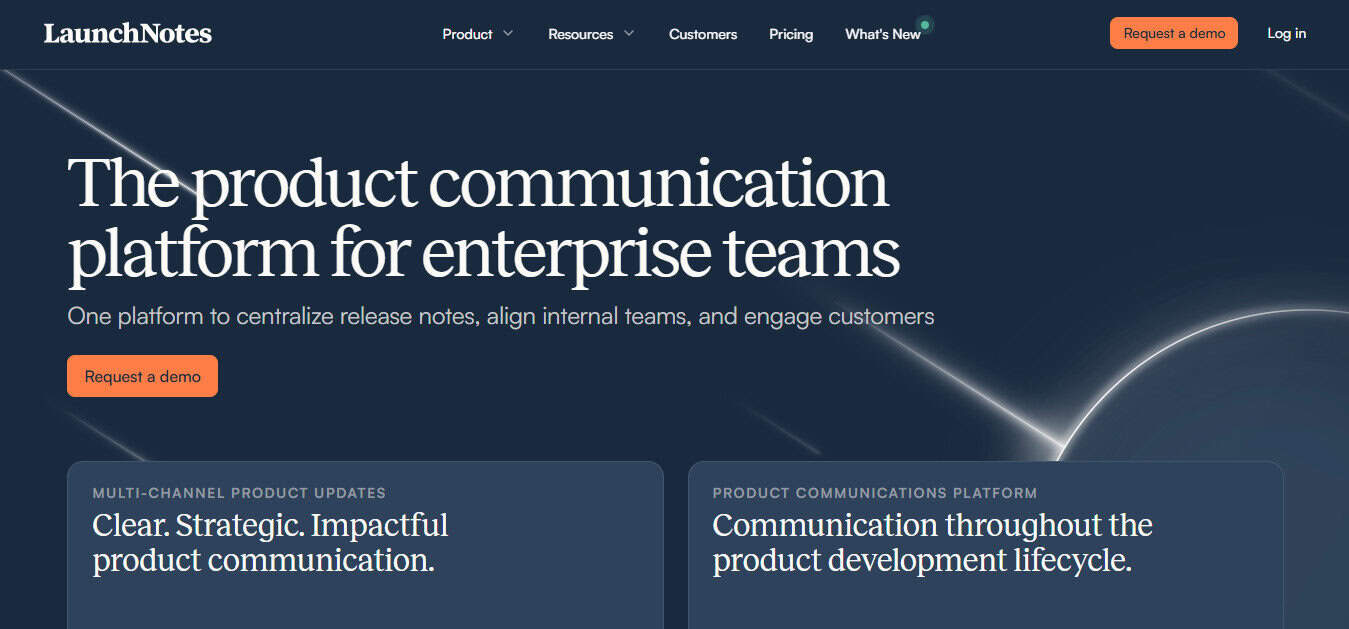- Why use a Changelog
- What is a Changelog?
- Best Practices for Changelog Formats
- Software Tools to Help Manage this Process
- Best Changelog Format Ideas
- 1. Start with your Changelog Entry:
- 2. Formatting:
- 3. Ordering your Changelog
- 4. Targeted Audience / Segmented User Groups
- 5. Additional Information
- 6. Allow User Feedback
- 7. What to Avoid in your Changelog:
Last Updated on October 3, 2025 by Ewen Finser
Why use a Changelog
Before we dive into the details, let’s take a step back and remember the purpose of a changelog. A changelog allows users to see an up-to-date list of significant changes or updates they may require insight into.
You can also gather feedback on an item listed in the changelog to determine whether recent changes or fixes are useful.
What is a Changelog?
Although changelogs are sometimes used interchangeably with release notes, it’s important to remember that they differ and shouldn’t be used in the same way.
While they both communicate critical product updates, the audience and content are slightly different. Here’s a quick overview of the typical differences:
Release notes | Changelog | |
Audience | Typically aimed at users, external users, stakeholders, or customers | Typically aimed at internal or power users, technical individuals, or developers. However, this can also be for external users. |
Content | What has changed (at a high level), how does this impact the user, and why does this matter? | A detailed, exhaustive list of what has changed. Includes a chronological history of what was changed and when. May consist of actions that need to be taken urgently. |
A Changelog is generally used for internal teams and power users. You’ll need to communicate key changes chronologically, detailing any changes made to a product.
Change logs often include important updates relating to:
- Bug fixes
- Features that have been added
- Updates to key features or functions
- Improvements or enhancements
Best Practices for Changelog Formats
Following best practice guidelines is essential to ensure you have the correct details in the proper format to deliver the message as effectively as possible.
- Remember that you’re communicating with humans, so when writing changelogs or release notes, highlight and order key information based on what the reader wants to see.
For example, if you’re communicating about a commonly raised issue on a feature that has now been improved or fixed, make it clear and stand out. The same would go for a bug fix: include crucial information related to correctly upgrading and overcoming issues. - Start by sorting this detail by importance.
- Remember to exclude any unnecessary information.
Software Tools to Help Manage this Process
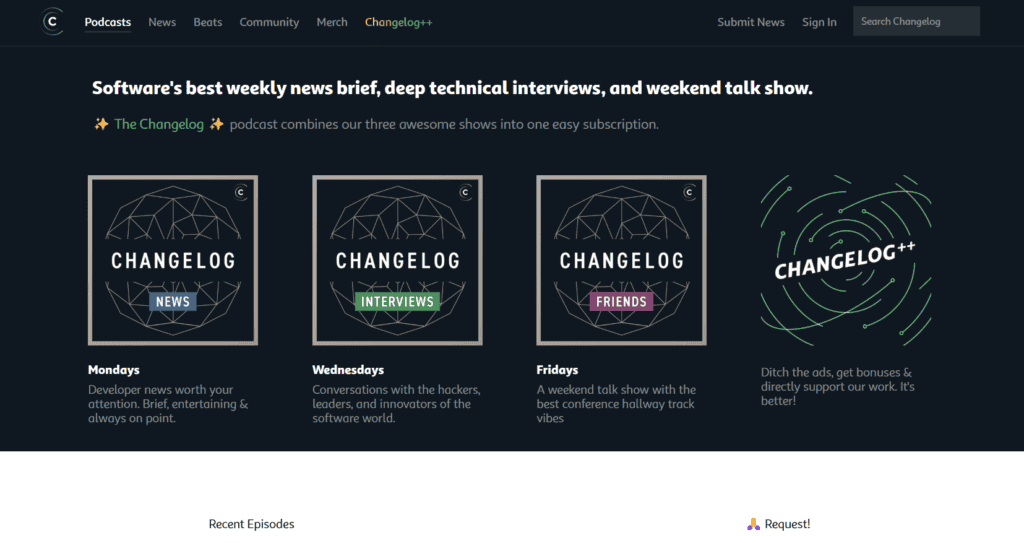
To help streamline this process, I prefer to use a well-rounded changelog or release notes tool.
Product management software can help by:
- Keeping teams and users aligned
- Segment audiences for targeted updates
- Automate manual and administrative tasks
- Ensure consistency across multiple communication channels
- Centralize release notes and Changelog details
- Reduce administrative-heavy activities by using templates
- Help display updates clearly and professionally
Here are my tips for best practice with practical examples using LaunchNotes, one of my favorite changelog and release notes tools!
You might also be interested in: LaunchNotes Review
LaunchNotes takes the busywork out of product updates. Paste in your notes or tickets and get a structured announcement draft instantly. It’s designed for teams that want to save time, segment updates, and keep communication consistent across every channel.
Best Changelog Format Ideas
1. Start with your Changelog Entry:
Changelog entries document updates to a product or software, so you’ll want to start by structuring and grouping your entry based on what this update relates to.
Organize entries by update type:
- Added – Refers to new features or capabilities
- Changed – This refers to existing features
- Deprecated – Refers to any functionalities or features scheduled for removal
- Removed – Refers to any functionalities or features that have been removed
- Security – Referring to any vulnerability patches, security fixes, or upgrades
- Fixed – Bug fixes and can include any technical fixes or improvements
I like using LaunchNotes templates to get started, as using content frameworks saves a lot of time.
I like to edit my templates to create branded, professional, and uniform layouts so that all announcements have the same look and feel.

- Templates can be a helpful starting point for new users unfamiliar with best practice formats for announcements or changelogs.
- Templates like these also have additional help text to guide your content baseline so you don’t forget any critical sections. Pay attention to user impact and remember to detail this information clearly.
Here’s an example of a guideline that LaunchNotes includes on their template for bug fixes:
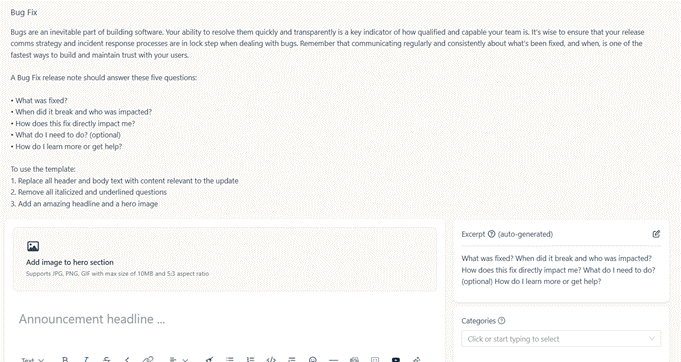
2. Formatting:
Markdown text is commonly used in changelog documentation and content because it can easily be converted into styled HTML.
I’d recommend using (HTML) or markdown in your changelog for the following reasons:
- Ease of formatting and consistency across websites, emails, or other platforms
- Markdown can assist with creating structured sections to highlight versions, updates, or entry types.
- Multiple developer tools (such as GitLab and GitHub) and changelog tools (such as Beamer or LaunchNotes) already use Markdown language, making integrating changes from one to the other easier.
Instead of general text like the following:

You can format your copy in Markdown first to display like below, then transpose it into your update in your software tool.
There are multiple markdown tools available to assist in generating this content.

Although this might look bland, it will display beautifully once published, with relevant section breaks and important dates, words, or phrases in bold or italic text.
Here’s an example:

I love LaunchNotes because you can also use the AI-Assistant to generate this content for you in the best layout (in markdown) to ensure that it displays optimally across multiple platforms.
You can input a feature brief or PRD with a prompt like “Write a changelog-style summary that highlights user impact for critical changes,” and you’ll be able to generate relevant and specific content.
Here’s the prompt I used for the above content and the result of the rendered “AI optimized” output.
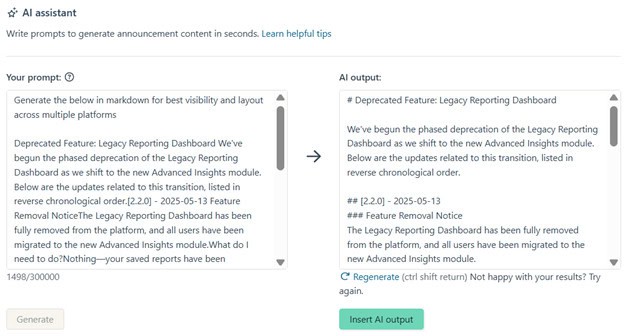
As a result, this tool helped render a better layout, correctly sized headers and subheaders, bold items, and clear section breaks with bullet points.

Note: Don’t forget best practices regarding additional format considerations.
This includes your date format:
- Include the date of the change or update to your entry.
- Use a global date format, ideally ISO 8601, to avoid ambiguity or confusion across multiple regions. This is the format (year-month-day) shown as YYYY-MM-DD.
- Ensure you stick to this uniform formatting for all changelogs and release notes to avoid confusion.

3. Ordering your Changelog
Ensure your latest versions come first!
Readers want to see the most recent updates first. However, you should include previous notes so that there is a trail for reference of any previous versions and changes made.
- Use version numbers to help indicate which update links to the most recent version.
- Best practice is to use reverse chronological ordering.

4. Targeted Audience / Segmented User Groups
Indicate if an update only affects specific users, groups, or audiences. Most tools allow you to use segmentation to outline this clearly. This is especially important if you have communications that must be separate for internal vs external users.
If you use a tool, this may be easier; however, if you don’t have one to help manage this, you may need to maintain separate changelogs, which can be cumbersome when you have multiple updates to publish.
Here’s how I use LaunchNotes to segment my audience for my changelogs.
I use a feature for cohorts within the tool to actively target a group of subscribers (or grouped by domains) for email update notifications.
Once you’ve created this specified list, you can easily send changelog updates directly to these users – even if they’ve not subscribed to them – which is ideal for critical updates.

I also prefer to categorize and/or label changelogs to help further segment critical updates to ensure they’re not missed.

5. Additional Information
- Always include links or additional context for users to access if needed.
- You’ll want to avoid having too much content in your changelog, but it’s a good idea to provide access to a knowledge base or support articles should users need more information.
- You can also provide links to GitHub issues or pull requests for ease of reference.
- If you have a support channel or email address, include a way for users to contact you, especially regarding critical updates.
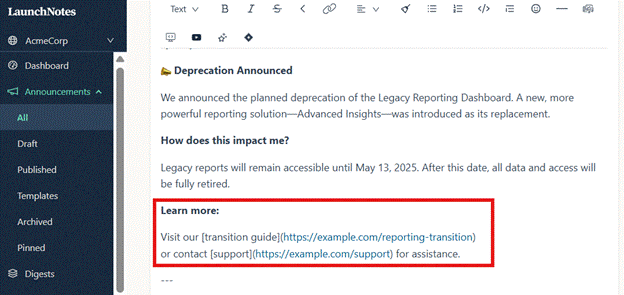
6. Allow User Feedback
- If you have a tool that allows in-app feedback, this is a great way to gather user sentiment or concerns.
- I also prefer to use tools to manage this, as they allow the correct user groups to submit feedback.

Changelog updates may be critical and need to be attended to urgently.
Having this information arrive directly in your inbox is a great way to centralize feedback and make it easier to manage and organize.

7. What to Avoid in your Changelog:
- Inconsistent formatting, tone, and style.
- If you have multiple users creating changelogs or large teams, you’ll want to maintain consistent structure, formats, and terminology.
- Technical jargon, confusing terminology, or any language that may be confusing for non-technical individuals.
- Vague information or missing context. Ensure the information is clear and helps users understand what is impacted and how.
There are additional considerations to keep in mind when adding more in-depth content to changelogs. However, this guide should help you follow some basic structure formats to ensure you’re keeping up to date with best practice guidelines!


